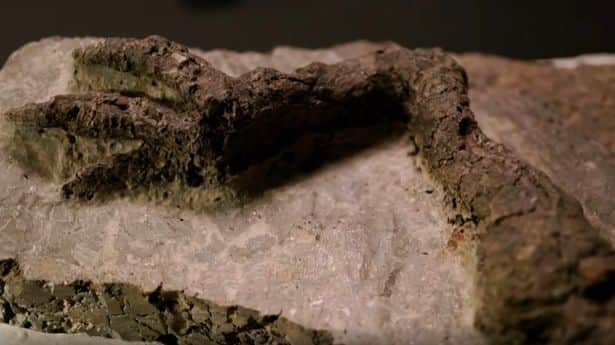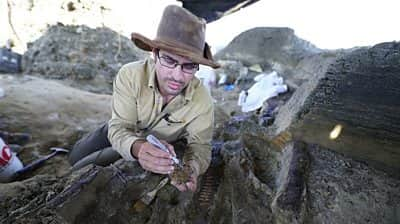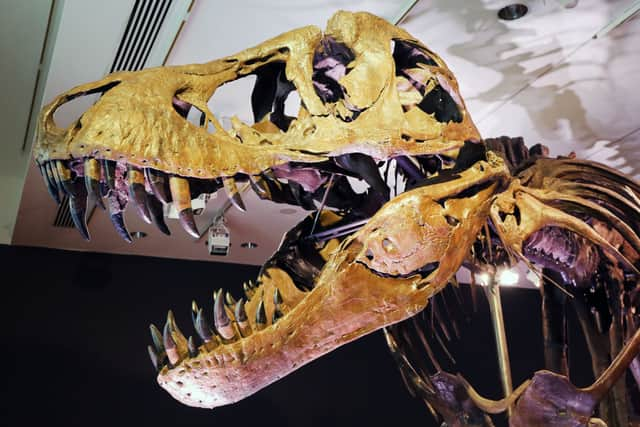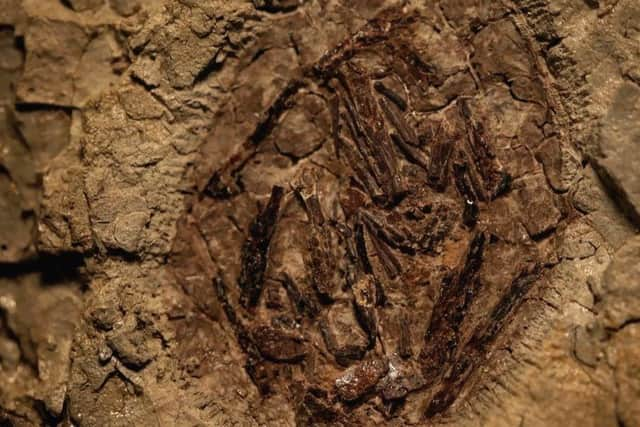Dinosaur leg: where was new fossil found, when did asteroids kill dinosaurs, and what does discovery mean?
This article contains affiliate links. We may earn a small commission on items purchased through this article, but that does not affect our editorial judgement.
and live on Freeview channel 276
Scientists have found what they believe to be an incredible insight into the last day of the dinosaurs on earth, with a new discovery found at the Tanis fossil site.
The discovery is a perfectly preserved leg of a dinosaur which even includes parts of the animal’s skin. It can be accurately traced back to when the asteroid that triggered the extinction of dinosaurs on Earth 66 million years ago.
Advertisement
Hide AdAdvertisement
Hide AdSpeaking to BBC Radio 4, Professor of Natural History at the University of Manchester, Phillip Manning, said: “The time resolution we can achieve at this site is beyond our wildest dreams.
“This really should not exist and it’s absolutely gobsmackingly beautiful.
“I never dreamt in all my career that I would get to look at something a) so time-constrained; and b) so beautiful, and also tells such a wonderful story.”
This is everything you need to know.
What’s the new fossil that’s been discovered?
Scientists have discovered the preserved leg of a dinosaur from the Tanis fossil site which is believed to have belonged to a dinosaur which was killed on the day of the asteroid strike that occurred 66 million years ago that led to almost all species on Earth to become extinct.
Advertisement
Hide AdAdvertisement
Hide AdThe finding was first reported by the BBC as the organisation and David Attenborough have spent the last three years filming at the site for its upcoming feature Dinosaurs: The Final Day, which will air on BBC One on 15 April at 6:30pm.


Robert DePalma, the University of Manchester graduate student who leads the Tanis dig, said: “We’ve got so many details with this site that tell us what happened moment by moment, it’s almost like watching it play out in the movies.
“You look at the rock column, you look at the fossils there, and it brings you back to that day.”
Professor Paul Barrett, Dinosaur Researcher at London’s Natural History Museum, identified the leg as belonging to a “Thescelosaurus”.
Advertisement
Hide AdAdvertisement
Hide AdHe said: “It’s a Thescelosaurus. It’s from a group that we didn’t have any previous record of what its skin looked like, and it shows very conclusively that these animals were very scaly like lizards. They weren’t feathered like their meat-eating contemporaries.


"This looks like an animal whose leg has simply been ripped off really quickly. There’s no evidence on the leg of disease, there are no obvious pathologies, there’s no trace of the leg being scavenged, such as bite marks or bits of it that are missing.
"So, the best idea that we have is that this is an animal that died more or less instantaneously.”
According to Barrett, this discovery “could be the first bit of dinosaur ever found that died as a direct result of being caught in the cataclysm that occurred after the asteroid hit”.
What else was discovered?
Advertisement
Hide AdAdvertisement
Hide AdA fragment of the Chicxulub asteroid may have also been found as well. The Chicxulub asteroid was roughly the size of Mount Everest and, when it struck the Gulf of Mexico, it launched molten rock into space.
The molten rock fragments then solidified and rained down back on the earth as “spherules”, glass beads which were scattered across thousands of miles.
In two of these spherule particles recovered from preserved tree resin, there is evidence to believe that they may contain a microscopic amount of material from the asteroid.


Professor Phillip Manning, Professor of Natural History at the University of Manchester, said: “When we noticed there were inclusions within these little glass spherules, we chemically analysed them at the Diamond X-ray synchrotron near Oxford.
Advertisement
Hide AdAdvertisement
Hide Ad“We were able to pull apart the chemistry and identify the composition of that material. All the evidence, all of the chemical data, from that study suggests strongly that we’re looking at a piece of the impactor; of the asteroid that ended it for the dinosaurs.”
What is the Tanis fossil site?
The Tanis fossil site is the name of a site located in southwestern North Dakota, in the United States, which is an area of great paleontological interest. It is believed that the site holds a record of the events of the impact of the Chicxulub asteroid in great detail.
The site was originally discovered in 2008 by University of North Georgia Professor Steve Nicklas and palaeontologist Rob Sula. DePalma was then brought in to perform additional excavations.
The Tanis site was first described in a New Yorker Magazine article in 2019, which, at the time, caused a stir in the scientific community as some of the findings presented in the article were not included in a scientific paper about the site.


Advertisement
Hide AdAdvertisement
Hide AdUsually the presentation of new discoveries are made in that of a scholarly journal.
Kirk Johnson, director of the Smithsonian’s National Museum of Natural History, said at the time: “Unfortunately, many interesting aspects of this study appear only in the New Yorker article and not in the scientific paper.
“This is a sloppy way to conduct science and it leaves open many questions. At the present moment, interesting data are presented in the paper while other elements of the story that could be data are, for the moment, only rumours.”
Since then, peer-reviewed papers about the site have since been published.
Advertisement
Hide AdAdvertisement
Hide AdTalking about the site, David Attenborough said: “Tanis could be a place where the remains can give us an unprecedented window into the lives of the very last dinosaurs, and a minute-by-minute picture of what happened when the asteroid hit.”
When did the asteroid kill the dinosaurs?
The asteroid that killed the dinosaurs hit earth some 66 million years ago. The asteroid, called Chicxulub, struck the waters off of what is now Mexico, which triggered the extinction of more than 75% of species on earth.
Following the impact, powerful earthquakes rocked the crust of the planet, causing tsunamis more than 150 feet tall to batter the shores of North America.
Wildfires were also ignited by the searing heat of the asteroid’s impact, even thousands of miles away from the site.
Advertisement
Hide AdAdvertisement
Hide AdAfter, earth was plunged into what has been described as a “nuclear winter” which lasted for years after the asteroid strike.


According to a study conducted by Nature, the asteroid that wiped out the dinosaurs hit the earth in spring.
Lead author of the study, Melanie During from Uppsala University, said: “The carbon isotope signal across the growth record of this unfortunate paddlefish confirms that the feeding season has not yet climaxed - death came in spring.”
According to the team behind the study, this revelation can help to explain why some animals, like birds, crocodiles and turtles, survived the disaster.
Advertisement
Hide AdAdvertisement
Hide AdDuring said: “This crucial finding will help to uncover why most of the dinosaurs died out while birds and early mammals managed to evade extinction.”
Spring in the northern hemisphere coincides with autumn in the southern hemisphere, meaning those that were preparing for winter, rather than being out and about hunting and looking for mates, were given an advantage.
Comment Guidelines
National World encourages reader discussion on our stories. User feedback, insights and back-and-forth exchanges add a rich layer of context to reporting. Please review our Community Guidelines before commenting.
